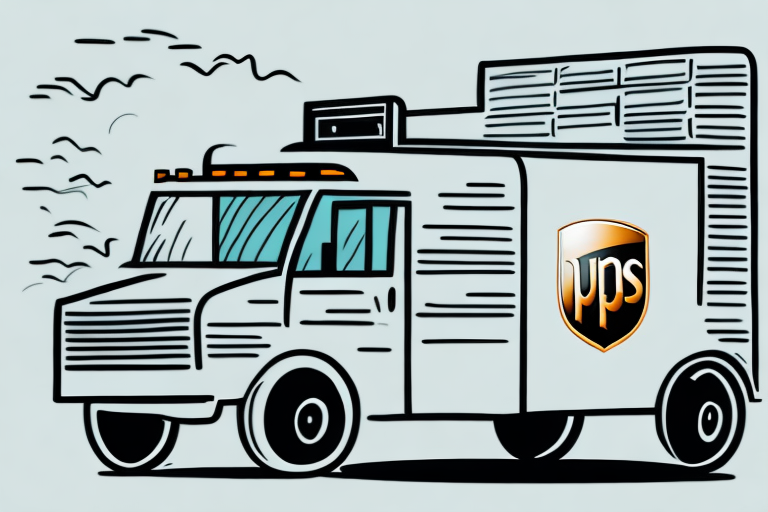UPS (United Parcel Service) is one of the world's largest shipping companies that offers both domestic and international shipping. In addition to standard shipping services, they also provide return shipping services to their customers. UPS return shipping rates are an important factor to consider for businesses that frequently process returns. In this article, we'll discuss the factors that determine UPS return shipping rates, how to calculate them, and provide tips to reduce their associated costs.
Why Return Shipping Rates Matter
Return shipping rates are an essential component of any e-commerce business. The cost of return shipping can significantly impact a business's bottom line. When customers return products, they expect a hassle-free and affordable process. Providing a cost-effective return shipping option can enhance customer satisfaction and loyalty. On the other hand, high return shipping costs can dissuade customers from making a future purchase and also cut into the profitability of the business.
One way to reduce return shipping costs is to offer free returns. While this may seem counterintuitive, studies have shown that customers are more likely to make a purchase if they know they can easily return the product for free. Additionally, offering free returns can help build trust with customers and increase brand loyalty.
Another factor to consider when it comes to return shipping rates is the environmental impact. Shipping products back and forth can have a significant carbon footprint. By offering alternative options such as in-store returns or recycling programs, businesses can reduce their environmental impact while also providing a convenient and cost-effective return process for customers.
What Determines UPS Return Shipping Rates?
The cost of a UPS return shipment is calculated based on several factors. These factors include distance, package weight, and shipping speed. The longer the distance the package needs to be shipped, the higher the cost. Similarly, the heavier the package, the higher the return shipping cost. Moreover, if the customer requests expedited shipping, the cost of return shipping will be higher than standard shipping.
Another factor that determines UPS return shipping rates is the type of package being shipped. For example, if the package is fragile or requires special handling, the cost of return shipping will be higher. Additionally, the value of the package being shipped can also impact the cost of return shipping. Higher value items may require additional insurance, which can increase the cost of shipping.
It's important to note that UPS offers various shipping options, including ground, air, and international shipping. The cost of return shipping will vary depending on the shipping option selected. Customers can use the UPS website or contact customer service to determine the most cost-effective shipping option for their return.
Types of UPS Return Shipping Rates
UPS offers two types of return shipping rates. The first is called "return label basis," which means that the rate is determined based on the label that is affixed to the package. The second type is called "call tag basis," which means that UPS picks up the package from the customer's location and then creates a return label. The call tag basis is typically more expensive than the return label basis due to the added convenience of pick up service.
It is important to note that the cost of return shipping may also vary depending on the weight and dimensions of the package being returned. Additionally, UPS offers different levels of service for return shipping, such as ground or expedited shipping, which can also affect the cost. It is recommended to compare the different options and rates before selecting a return shipping method with UPS.
Tips for Reducing UPS Return Shipping Costs
Businesses should consider the following tips to reduce their UPS return shipping costs:
- Offering free return shipping - This can increase customer loyalty and repeat business while also encouraging customers to return items they may have been hesitant to before.
- Reducing package weight - Lighter packages typically have lower shipping costs than heavier packages. Businesses should consider using lightweight packaging materials whenever possible.
- Reducing distance - Businesses with multiple warehouses and locations can consider routing returns to the location closest to the customer to reduce shipping distance and costs.
In addition to the above tips, businesses can also consider using UPS's online tools to manage their return shipping costs. UPS offers a variety of tools that can help businesses track their shipments, manage their returns, and optimize their shipping routes to reduce costs.
Another way to reduce UPS return shipping costs is to negotiate rates with UPS directly. Businesses that ship large volumes of packages may be able to negotiate lower rates with UPS, which can help them save money on return shipping costs.
How to Calculate UPS Return Shipping Rates
The most accurate way to calculate UPS return shipping rates is by using the UPS website's online shipping calculator. Simply enter the shipping address, weight of the package, shipping speed, and other relevant information to receive an estimate of the return shipping cost. Additionally, businesses can contact UPS directly for a customized estimate based on their specific needs.
It is important to note that UPS return shipping rates may vary depending on the type of item being shipped. For example, hazardous materials or oversized packages may incur additional fees. It is recommended to check with UPS or refer to their website for more information on specific shipping requirements and associated costs.
Another factor to consider when calculating UPS return shipping rates is the destination country. International shipping rates may differ from domestic rates and may also be subject to customs fees and taxes. It is important to research and understand these additional costs before shipping internationally with UPS.
Comparing UPS Return Shipping Rates to Other Carriers
It's important to compare UPS return shipping rates to other carriers to ensure businesses are getting the best value. FedEx, DHL, and USPS are other popular shipping options that also offer return services. By comparing rates, businesses can choose the most cost-effective option for their needs.
However, it's not just about the cost of return shipping. Businesses should also consider the reliability and speed of each carrier's return service. UPS has a reputation for reliable and timely delivery, which can be crucial for businesses that need to process returns quickly. Additionally, UPS offers a range of return options, including drop-off at UPS locations, pickup by a UPS driver, and even printing return labels directly from their website. By considering all of these factors, businesses can make an informed decision about which carrier to use for their return shipping needs.
Ways to Negotiate Better UPS Return Shipping Rates
Businesses that process a high volume of returns can negotiate better UPS return shipping rates. UPS offers volume-based discounts for businesses that ship a certain number of packages per month. Additionally, businesses can contact UPS directly to negotiate customized rates based on their specific needs.
Another way to negotiate better UPS return shipping rates is to explore alternative shipping options. For example, businesses can consider using USPS or FedEx for certain types of returns, as they may offer more competitive rates for specific shipping needs. It's also important to regularly review and compare shipping rates from different carriers to ensure that you are getting the best deal possible.
Understanding Additional Fees and Surcharges in UPS Return Shipping Rates
UPS return shipping rates can also include additional fees and surcharges. These include fuel surcharges, remote area surcharges, and residential delivery surcharges. Businesses should be aware of these additional charges to accurately budget for return shipping costs.
Fuel surcharges are added to UPS return shipping rates to account for the fluctuating cost of fuel. This surcharge is calculated based on the current market price of fuel and can vary from month to month. It is important for businesses to keep this in mind when budgeting for return shipping costs, as the fuel surcharge can significantly impact the overall cost of shipping.
In addition to fuel surcharges, UPS may also apply remote area surcharges to return shipping rates. These surcharges are added when a shipment is being delivered to a remote or hard-to-reach location. This can include areas such as rural communities or mountainous regions. Businesses should be aware of these surcharges and factor them into their return shipping costs, especially if they frequently ship to remote areas.
How Technology Can Help Manage UPS Return Shipping Rates
Businesses can use technology to manage and monitor their UPS return shipping rates. Shipping software can automate the shipping process, reducing manual errors and improving efficiency. Additionally, shipping software can compare shipping rates across multiple carriers to ensure businesses are getting the best possible value.
Common Mistakes to Avoid When Calculating UPS Return Shipping Rates
Businesses should avoid the following common mistakes when calculating UPS return shipping rates:
- Underestimating the package weight - This can result in additional fees and surcharges for the business.
- Forgetting to include additional fees and surcharges - These charges can significantly impact the overall cost of return shipping.
- Not considering the distance of the shipment - Shipping distance is an essential factor in calculating return shipping rates.
Examples of Real-World UPS Return Shipping Scenarios and Their Costs
Here are a few examples of real-world UPS return shipping scenarios and their costs:
- A small package weighing two pounds being shipped back to a warehouse within the same state as the customer costs around $10 with standard shipping and $25 with expedited shipping.
- A medium-sized package weighing 10 pounds being shipped back to an out-of-state warehouse costs around $40 with standard shipping and $80 with expedited shipping.
Understanding the Impact of Distance on UPS Return Shipping Rates
The distance the package needs to travel significantly impacts the return shipping rate. The farther the distance, the higher the cost. Businesses with multiple warehouses and locations can mitigate this impact by routing returns to the closest location.
Analyzing the Impact of Package Weight on UPS Return Shipping Costs
The weight of the package also has a significant impact on return shipping costs. Heavier packages typically have higher shipping costs. Businesses can use lightweight packaging materials to reduce the package's weight and lower associated return shipping costs.
Strategies for Managing High Volume Returns and Their Associated Costs
Businesses with high volume returns can implement the following strategies to manage associated costs:
- Negotiating customized shipping rates with UPS based on their specific needs and high yearly shipping volume.
- Using technology to automate the shipping process and reduce manual errors.
- Offering free return shipping to incentivize customers to return items.
- Managing package weight and distance to reduce shipping costs.
The Future of UPS Return Shipping Rates: Trends and Predictions
The future of UPS return shipping rates includes advancements in technology and more personalized shipping options for customers. UPS is implementing technologies like drones and autonomous delivery vehicles to reduce shipping costs. Additionally, UPS is testing new, innovative last-mile delivery methods like trunk delivery and locker-based delivery.
Conclusion
In conclusion, understanding UPS return shipping rates is an essential component of any e-commerce business. By considering factors like distance, package weight, and shipping speed, businesses can accurately calculate return shipping costs, negotiate better rates, and offer cost-effective return shipping options to their customers. With the continued advancement of technology and new delivery methods like drones and autonomous vehicles, businesses can expect to see more efficient and cost-effective return shipping options in the future.









